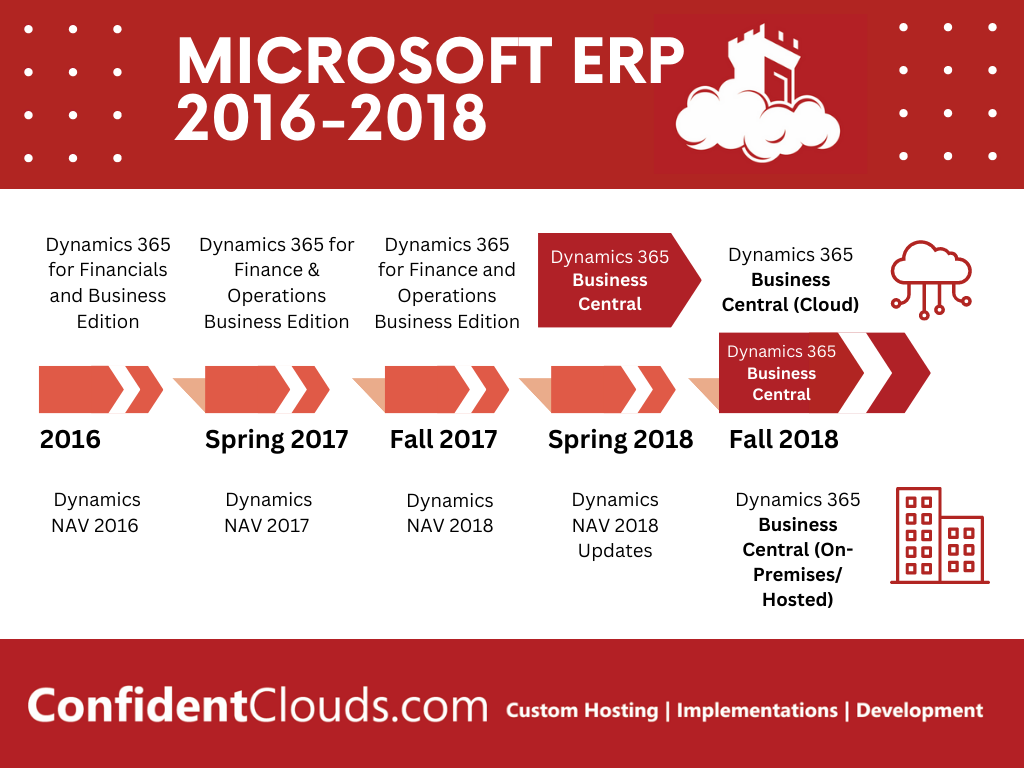Evolution of Microsoft Dynamics ERP Solutions – Part 2
In the last few years, Microsoft has shown its commitment to providing a seamless and unified experience across its suite of business applications. Dynamics 365 is designed to integrate with other Microsoft solutions, such as Office 365, Power BI, and Teams. This integration allows businesses to create a unified platform that leverages the power of multiple solutions to streamline workflows and increase productivity. For example, employees can access Dynamics 365 data from within Microsoft Teams, or use Power BI to create custom reports and dashboards that pull data from Dynamics 365. The evolution of Microsoft Dynamics ERP solutions has been characterized by several key trends and developments. Here are some additional details:
1. Emphasis on scalability and flexibility: From the earliest days of Axapta, Dynamics GP, Navision, and Solomon, Microsoft has emphasized the importance of scalability and flexibility in its ERP solutions. These solutions have been designed to be modular, with a range of modules that can be added or removed depending on the needs of the business. This approach allows businesses to start with a basic set of functionalities and expand as their needs grow.
2. Emphasis on data analytics and business intelligence: Microsoft Dynamics ERP solutions have always provided robust reporting and analytics capabilities, but in recent years, the company has placed an even greater emphasis on data analytics and business intelligence. Dynamics 365 includes built-in business intelligence tools, such as Power BI, which can be used to create custom dashboards and reports.
3. Move towards cloud-based solutions: Microsoft Dynamics 365 represents a major shift in the way that Microsoft delivers ERP solutions. Dynamics 365 is a cloud-based solution, meaning that businesses can access it from anywhere with an internet connection. This approach offers a few benefits, including lower upfront costs, easier deployment and maintenance, and greater scalability and flexibility.
4. Integration with other Microsoft products: Microsoft has always focused on delivering integrated solutions that work seamlessly with other Microsoft products. This is particularly true of Dynamics 365, which is designed to integrate with other Microsoft products like Power BI, Power Apps, and Microsoft Teams. This approach allows businesses to create a unified platform that streamlines workflows and increases efficiency.
5. Increased focus on user experience: Microsoft has also placed a greater emphasis on user experience in its ERP solutions. Dynamics 365 features a modern and intuitive interface that is designed to be easy to use and navigate. This approach helps businesses increase user adoption and productivity, which can lead to greater ROI and business success.
6. Emphasis on analytics and machine learning: With the rise of big data and the increasing availability of advanced analytics tools, Microsoft has placed a greater emphasis on analytics and machine learning in its ERP solutions. Dynamics 365 includes a range of advanced analytics tools, including predictive analytics and machine learning capabilities, that can help businesses gain insights and make better decisions based on real-time data. Microsoft has been investing heavily in artificial intelligence (AI) and machine learning (ML) technologies, and these investments are being integrated into Dynamics 365. For example, the system can analyze data to predict customer behavior and suggest the best course of action. This AI-driven approach can help businesses improve customer satisfaction and drive revenue growth.
7. Mobile accessibility: With the increasing importance of mobile devices in the workplace, Microsoft has made its ERP solutions more accessible from mobile devices. Dynamics 365 features a responsive design that can be accessed from any device with an internet connection. This allows employees to access critical business information from anywhere, at any time, which can increase efficiency and productivity.
8. Industry-specific solutions: Microsoft has also developed industry-specific solutions for a range of verticals, including manufacturing, retail, and healthcare. These solutions are designed to address the unique needs and challenges of each industry, and they include preconfigured templates, workflows, and reports that can help businesses get up and running quickly.
9. Integration with third-party solutions: Microsoft has also placed a greater emphasis on integration with third-party solutions. Dynamics 365 includes a range of APIs and connectors that allow businesses to integrate with other systems, including CRM systems, marketing automation platforms, and other business-critical solutions. This approach helps businesses create a unified platform that streamlines workflows and increases efficiency.
10. Support for hybrid deployments: Microsoft understands that not all businesses are ready to move to the cloud and has provided support for hybrid deployments. This means that businesses can run some of their ERP solutions on-premises while using cloud-based solutions for other functions. This hybrid approach can help businesses take advantage of the benefits of cloud technologies while still maintaining control over their critical data.
In conclusion, the evolution of Microsoft Dynamics ERP solutions has been driven by a focus on delivering flexible, scalable, and integrated solutions that can help businesses of all sizes and industries become more efficient, effective, and competitive. The move towards cloud-based solutions, the emphasis on user experience and mobile accessibility, the focus on industry-specific solutions and integration with third-party solutions, and the adoption of AI-powered features and seamless integration with other Microsoft solutions are just a few examples of how Microsoft is continuing to innovate and evolve in the ERP market.
Finally, Microsoft is committed to providing a platform that is easy to use, intuitive, and accessible to users of all skill levels. The company has invested heavily in user experience and has made significant improvements to the user interface of its ERP solutions over the years. Dynamics 365 features a modern, web-based interface that is easy to navigate and can be customized to suit the needs of individual users. Additionally, Microsoft has made its ERP solutions accessible from mobile devices, enabling employees to access data and workflows from anywhere, at any time. Microsoft is ensuring that its ERP solutions remain relevant and useful in a rapidly changing business landscape.


Comments are closed.